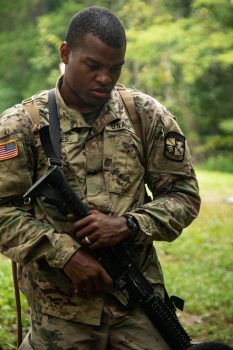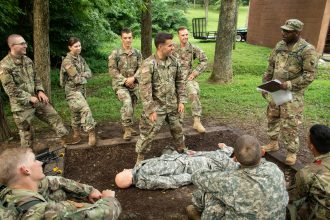FORT KNOX, KY.— Cadets from 9th Regiment, Advanced Camp put down their weapons, and picked up their med kits for First Aid training on July 18.

Cadet Jordan Hayes, from the University of Hawaii – Manoa, attentively watches Cadre demonstrate how to provide combat care under fire to an injured battle buddy during First Aid training at Fort Knox, July 18, 2019. | Photo by Jodi Moffett, CST Public Affairs Office
Throughout the summer, Cadets have learned how to communicate and work with their battle buddies to keep each other safe during combat. First Aid training requires them to take on the scenario that their battle buddy has been wounded, and it’s up to them to help treat their wounds, and get them to safety.
Before the Cadets can begin medical aid on their wounded battle buddy, they must first suppress fire from the enemy.
Cadet Lucas Coffey, from Eastern Michigan University, expresses just how important this first step is when providing combat care under fire.
“Safety is key,” Coffey said. “In order to effectively start caring for your battle buddy, you have to eliminate any threat that could injure you, or further injure your battle buddy.”
After suppressing fire, the Cadets move over to their battle buddy, and look for any wounds. They are then taught the many ways to treat these wounds, and stop their battle buddy from bleeding.
This includes learning how to apply a tourniquet to stop major bleeding, and using gauze and pressure bandages on smaller wounds.
Throughout the rest of their training, Cadets learn how to use a Nasopharyngeal airway or “nasal trumpet”, which is inserted in through the nose to open up the airway. After bleeding and breathing is controlled, the Cadets give their battle buddies any pain medication they may need, and take them to the evacuation site until further help arrives.

Cadet Daniel Hughes, from Norwich University, practices listening for breathing when checking if his wounded battle buddy is responsive during his First Aid training at Fort Knox, July 18, 2019. This training teaches Cadets how to provide combat care under fire. | Photo by Jodi Moffett, CST Public Affairs Office
Some Cadets found all of this information to be overwhelming, but pushed through regardless. “It can be easy to panic and forget your training,” Cadet Daniel Hughes, from Norwich University said.
“In the past I was the kind of guy that locks up during high stress situations… but the army has taught me the skills and mindset needed to overcome that.”
Although this training was a simulation of life-saving medical care, some Cadets know the stress and importance of medical training all too well.
“I used to be a swim instructor for 6 years in southern California,” Cadet James Nguyen, from the University of California Davis, said.
“I actually saved a life once during my time there. She was only 8 years old, and she started
to drown and couldn’t breathe. I was the first to notice, so I was the one who had to rush in to help her. Just like CPR training, this training teaches us to always remain calm. That’s the only way you can be helpful in these kinds of situations.”

Cadet Michael Tabb, from Roger Williams University, practices providing combat care under fire as fellow Cadets and Cadre watch during First Aid training at Fort Knox, July 18, 2019. | Photo by Jodi Moffett, CST Public Affairs Office
Every Cadet has their own path in the Army, but despite their differences, all of the Cadets expressed just how important First Aid training is for their Army career.
“Human resources is my main goal in the Army, but medical services is definitely an option I’d like to keep open,” Nguyen said.
“Regardless of what fields we decide to go into, the training we receive here will help us accomplish our goals, and become capable and successful officers.”




